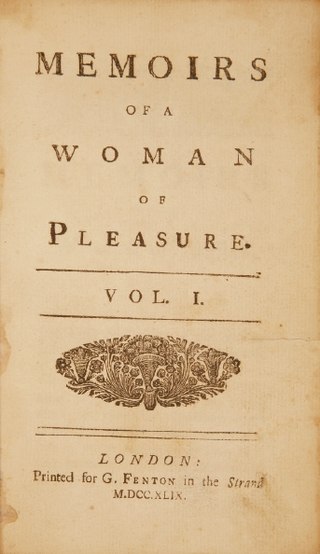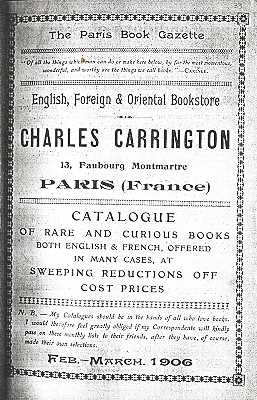
Frances Brooke was an English novelist, essayist, playwright and translator. Hers was the first English novel known to have been written in Canada.

Memoirs of a Woman of Pleasure—popularly known as Fanny Hill—is an erotic novel by the English novelist John Cleland first published in London in 1748. Written while the author was in debtors' prison in London, it is considered "the first original English prose pornography, and the first pornography to use the form of the novel". It is one of the most prosecuted and banned books in history.
The role of sadism and masochism in fiction has attracted serious scholarly attention. Anthony Storr has commented that the volume of sadomasochist pornography shows that sadomasochistic interest is widespread in Western society; John Kucich has noted the importance of masochism in late-19th-century British colonial fiction. This article presents appearances of sadomasochism in literature and works of fiction in the various media.
The sex-positive movement is a social and philosophical movement that seeks to change cultural attitudes and norms around sexuality, promoting the recognition of sexuality as a natural and healthy part of the human experience and emphasizing the importance of personal sovereignty, safer sex practices, and consensual sex. It covers every aspect of sexual identity including gender expression, orientation, relationship to the body, relationship-style choice, and reproductive rights. Sex-positivity is "an attitude towards human sexuality that regards all consensual sexual activities as fundamentally healthy and pleasurable, encouraging sexual pleasure and experimentation." It challenges societal taboos and aims to promote healthy and consensual sexual activities. The sex-positive movement also advocates for comprehensive sex education and safe sex as part of its campaign. The movement generally makes no moral distinctions among types of sexual activities, regarding these choices as matters of personal preference.
Theresa Berkley or Berkeley was a 19th-century English dominatrix who ran a brothel in Hallam Street, just to the east of Portland Place, Marylebone, London, specialising in flagellation. She is notable as the inventor of the "chevalet" or "Berkley Horse", a BDSM apparatus.

Erotic literature comprises fictional and factual stories and accounts of eros intended to arouse similar feelings in readers. This contrasts erotica, which focuses more specifically on sexual feelings. Other common elements are satire and social criticism. Much erotic literature features erotic art, illustrating the text.

Impact play is a human sexual practice in which one person is struck by another person for the gratification of either or both parties which may or may not be sexual in nature. It is considered a form of BDSM.

Lesbian erotica deals with depictions in the visual arts of lesbianism, which is the expression of female-on-female sexuality. Lesbianism has been a theme in erotic art since at least the time of ancient Rome, and many regard depictions of lesbianism to be erotic.

Lesbianism is the sexual and romantic desire between women. There are historically fewer mentions of lesbianism than male homosexuality, due to many historical writings and records focusing primarily on men.
Rosa Coote is a fictional dominatrix appearing as a stock character in a number of works of Victorian erotica, including The Convent School, or Early Experiences of A Young Flagellant by William Dugdale and "Letters to a Lady Friend" or "Miss Coote's Confession" in The Pearl. Henry Spencer Ashbee writes of The Convent School that "The book is not altogether badly written; no part of the narrative however is attractive".

Pornography has been defined as sexual subject material "such as a picture, video, or text" that is intended for sexual arousal. Intended for consumption by adults, pornography depictions have evolved from cave paintings, some forty millennia ago, to virtual reality presentations. A general distinction of adult content is made classifying it as pornography or erotica.
John Camden Hotten was an English bibliophile and publisher. He is best known for his clandestine publishing of numerous erotic and pornographic titles.

Charles Carrington (1857–1921) was a leading British publisher of erotica in late-19th- and early-20th-century Europe. Born Paul Harry Ferdinando in Bethnal Green, England on 11 November 1867, he moved in 1895 from London to Paris where he published and sold books in the rue Faubourg Montmartre and rue de Chateaudun; for a short period he moved his activities to Brussels. Carrington also published works of classical literature, including the first English translation of Aristophanes' "Comedies," and books by famous authors such as Oscar Wilde and Anatole France, in order to hide his "undercover" erotica publications under a veil of legitimacy. His books featured the erotic art of Martin van Maële. He published a French series La Flagellation a Travers le Monde mainly on English flagellation, identifying it as an English predilection.
The Cremorne was a pornographic magazine published by William Lazenby in London in 1882. The title alludes to Cremorne Gardens which had by that time become a haunt of prostitutes. The magazine was a sequel to The Pearl. The Cremorne folded in 1882.
George Cannon (1789–1854) was an English solicitor, radical activist and publisher and pornographer who also used the pseudonyms Erasmus Perkins and Philosemus.
Feminism has affected culture in many ways, and has famously been theorized in relation to culture by Angela McRobbie, Laura Mulvey and others. Timothy Laurie and Jessica Kean have argued that "one of [feminism's] most important innovations has been to seriously examine the ways women receive popular culture, given that so much pop culture is made by and for men." This is reflected in a variety of forms, including literature, music, film and other screen cultures.
The Library Illustrative of Social Progress was a series of pornographic books published by John Camden Hotten around 1872. They were mainly reprints of eighteenth-century pornographic works on flagellation. Hotten claimed to have found them in the library of Henry Thomas Buckle (1821–1862) but Henry Spencer Ashbee counterclaimed that they were in fact from his collection.
August or Auguste Brancart was a Belgian publisher of pornographic literature, credited with the first publication of My Secret Life. He published translations of English pornography into French and vice versa for English publishers such as Edward Avery. He also published work of the Decadent movement such as Monsieur Vénus by Rachilde.

Cultural history of the buttocks has included various art forms as well as a sexualization of the buttocks which has occurred throughout history.

Victorian erotica is a genre of sexual art and literature which emerged in the Victorian era of 19th-century Britain. Victorian erotica emerged as a product of a Victorian sexual culture. The Victorian era was characterized by paradox of rigid morality and anti-sensualism, but also by an obsession with sex. Sex was a main social topic, with progressive and enlightened thought pushing for sexual restriction and repression. Overpopulation was a societal concern for the Victorians, thought to be the cause of famine, disease, and war. To curb the threats of overpopulation and to solve other social issues that were arising at the time, sex was socially regulated and controlled. New sexual categories emerged as a response, defining normal and abnormal sex. Heterosexual sex between married couples became the only form of sex socially and morally permissible. Sexual pleasure and desire beyond heterosexual marriage was labelled as deviant, considered to be sinful and sinister. Such deviant forms included masturbation, homosexuality, prostitution and pornography. Procreation was the primary goal of sex, removing it from the public, and placing it in the domestic. Yet, Victorian anti-sexual attitudes were contradictory of genuine Victorian life, with sex underlying much of the cultural practice. Sex was simultaneously repressed and proliferated. Sex was featured in medical manuals such as The Sexual Impulse by Havelock Ellis and Functions and Disorders of Reproductive Organs by William Acton, and in cultural magazines like The Penny Magazine and The Rambler. Sex was popular in entertainment, with much of Victorian theatre, art and literature including and expressing sexual and sensual themes.









